Tobias Höllerer
Prism: Semi-Supervised Multi-View Stereo with Monocular Structure Priors
Dec 08, 2024Abstract:The promise of unsupervised multi-view-stereo (MVS) is to leverage large unlabeled datasets, yet current methods underperform when training on difficult data, such as handheld smartphone videos of indoor scenes. Meanwhile, high-quality synthetic datasets are available but MVS networks trained on these datasets fail to generalize to real-world examples. To bridge this gap, we propose a semi-supervised learning framework that allows us to train on real and rendered images jointly, capturing structural priors from synthetic data while ensuring parity with the real-world domain. Central to our framework is a novel set of losses that leverages powerful existing monocular relative-depth estimators trained on the synthetic dataset, transferring the rich structure of this relative depth to the MVS predictions on unlabeled data. Inspired by perceptual image metrics, we compare the MVS and monocular predictions via a deep feature loss and a multi-scale statistical loss. Our full framework, which we call Prism, achieves large quantitative and qualitative improvements over current unsupervised and synthetic-supervised MVS networks. This is a best-case-scenario result, opening the door to using both unlabeled smartphone videos and photorealistic synthetic datasets for training MVS networks.
Comparing Zealous and Restrained AI Recommendations in a Real-World Human-AI Collaboration Task
Oct 06, 2024



Abstract:When designing an AI-assisted decision-making system, there is often a tradeoff between precision and recall in the AI's recommendations. We argue that careful exploitation of this tradeoff can harness the complementary strengths in the human-AI collaboration to significantly improve team performance. We investigate a real-world video anonymization task for which recall is paramount and more costly to improve. We analyze the performance of 78 professional annotators working with a) no AI assistance, b) a high-precision "restrained" AI, and c) a high-recall "zealous" AI in over 3,466 person-hours of annotation work. In comparison, the zealous AI helps human teammates achieve significantly shorter task completion time and higher recall. In a follow-up study, we remove AI assistance for everyone and find negative training effects on annotators trained with the restrained AI. These findings and our analysis point to important implications for the design of AI assistance in recall-demanding scenarios.
* 15 pages, 14 figures, accepted to ACM CHI 2023
Multimodal 3D Fusion and In-Situ Learning for Spatially Aware AI
Oct 06, 2024
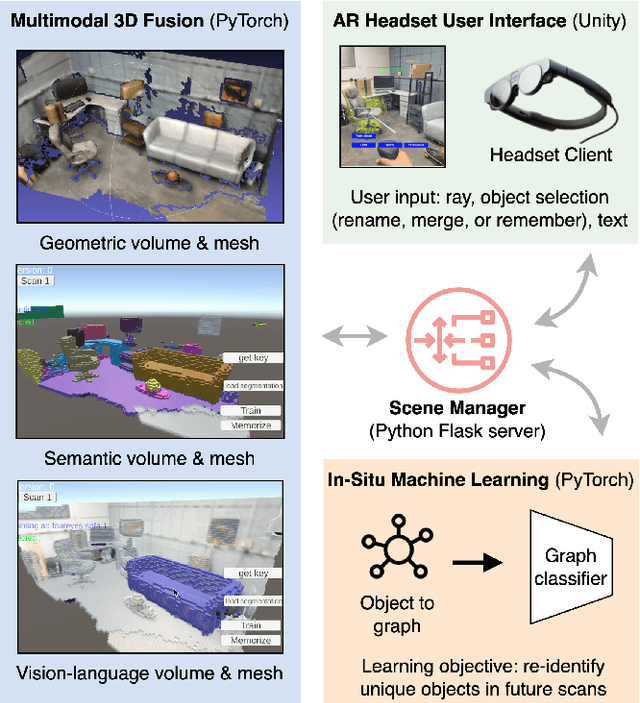
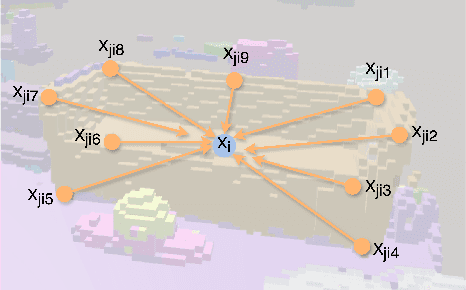

Abstract:Seamless integration of virtual and physical worlds in augmented reality benefits from the system semantically "understanding" the physical environment. AR research has long focused on the potential of context awareness, demonstrating novel capabilities that leverage the semantics in the 3D environment for various object-level interactions. Meanwhile, the computer vision community has made leaps in neural vision-language understanding to enhance environment perception for autonomous tasks. In this work, we introduce a multimodal 3D object representation that unifies both semantic and linguistic knowledge with the geometric representation, enabling user-guided machine learning involving physical objects. We first present a fast multimodal 3D reconstruction pipeline that brings linguistic understanding to AR by fusing CLIP vision-language features into the environment and object models. We then propose "in-situ" machine learning, which, in conjunction with the multimodal representation, enables new tools and interfaces for users to interact with physical spaces and objects in a spatially and linguistically meaningful manner. We demonstrate the usefulness of the proposed system through two real-world AR applications on Magic Leap 2: a) spatial search in physical environments with natural language and b) an intelligent inventory system that tracks object changes over time. We also make our full implementation and demo data available at (https://github.com/cy-xu/spatially_aware_AI) to encourage further exploration and research in spatially aware AI.
Mazed and Confused: A Dataset of Cybersickness, Working Memory, Mental Load, Physical Load, and Attention During a Real Walking Task in VR
Sep 10, 2024Abstract:Virtual Reality (VR) is quickly establishing itself in various industries, including training, education, medicine, and entertainment, in which users are frequently required to carry out multiple complex cognitive and physical activities. However, the relationship between cognitive activities, physical activities, and familiar feelings of cybersickness is not well understood and thus can be unpredictable for developers. Researchers have previously provided labeled datasets for predicting cybersickness while users are stationary, but there have been few labeled datasets on cybersickness while users are physically walking. Thus, from 39 participants, we collected head orientation, head position, eye tracking, images, physiological readings from external sensors, and the self-reported cybersickness severity, physical load, and mental load in VR. Throughout the data collection, participants navigated mazes via real walking and performed tasks challenging their attention and working memory. To demonstrate the dataset's utility, we conducted a case study of training classifiers in which we achieved 95% accuracy for cybersickness severity classification. The noteworthy performance of the straightforward classifiers makes this dataset ideal for future researchers to develop cybersickness detection and reduction models. To better understand the features that helped with classification, we performed SHAP(SHapley Additive exPlanations) analysis, highlighting the importance of eye tracking and physiological measures for cybersickness prediction while walking. This open dataset can allow future researchers to study the connection between cybersickness and cognitive loads and develop prediction models. This dataset will empower future VR developers to design efficient and effective Virtual Environments by improving cognitive load management and minimizing cybersickness.
OCTO+: A Suite for Automatic Open-Vocabulary Object Placement in Mixed Reality
Jan 17, 2024Abstract:One key challenge in Augmented Reality is the placement of virtual content in natural locations. Most existing automated techniques can only work with a closed-vocabulary, fixed set of objects. In this paper, we introduce and evaluate several methods for automatic object placement using recent advances in open-vocabulary vision-language models. Through a multifaceted evaluation, we identify a new state-of-the-art method, OCTO+. We also introduce a benchmark for automatically evaluating the placement of virtual objects in augmented reality, alleviating the need for costly user studies. Through this, in addition to human evaluations, we find that OCTO+ places objects in a valid region over 70% of the time, outperforming other methods on a range of metrics.
OCTOPUS: Open-vocabulary Content Tracking and Object Placement Using Semantic Understanding in Mixed Reality
Dec 20, 2023

Abstract:One key challenge in augmented reality is the placement of virtual content in natural locations. Existing automated techniques are only able to work with a closed-vocabulary, fixed set of objects. In this paper, we introduce a new open-vocabulary method for object placement. Our eight-stage pipeline leverages recent advances in segmentation models, vision-language models, and LLMs to place any virtual object in any AR camera frame or scene. In a preliminary user study, we show that our method performs at least as well as human experts 57% of the time.
Interactive Segmentation and Visualization for Tiny Objects in Multi-megapixel Images
Apr 21, 2022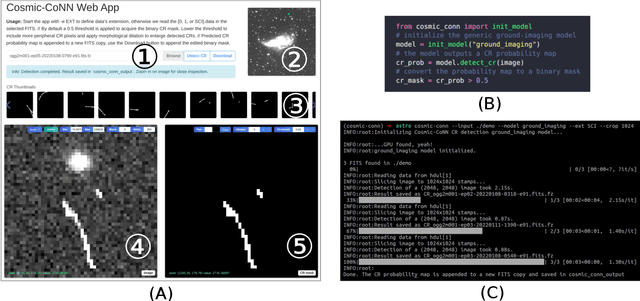

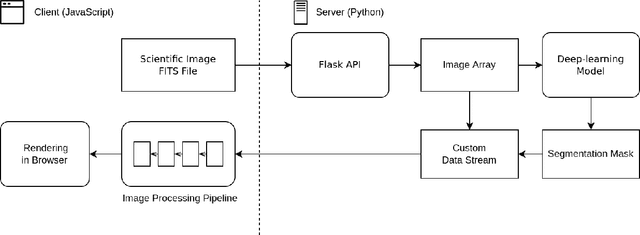
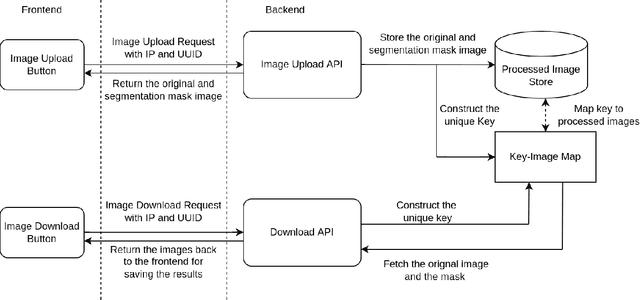
Abstract:We introduce an interactive image segmentation and visualization framework for identifying, inspecting, and editing tiny objects (just a few pixels wide) in large multi-megapixel high-dynamic-range (HDR) images. Detecting cosmic rays (CRs) in astronomical observations is a cumbersome workflow that requires multiple tools, so we developed an interactive toolkit that unifies model inference, HDR image visualization, segmentation mask inspection and editing into a single graphical user interface. The feature set, initially designed for astronomical data, makes this work a useful research-supporting tool for human-in-the-loop tiny-object segmentation in scientific areas like biomedicine, materials science, remote sensing, etc., as well as computer vision. Our interface features mouse-controlled, synchronized, dual-window visualization of the image and the segmentation mask, a critical feature for locating tiny objects in multi-megapixel images. The browser-based tool can be readily hosted on the web to provide multi-user access and GPU acceleration for any device. The toolkit can also be used as a high-precision annotation tool, or adapted as the frontend for an interactive machine learning framework. Our open-source dataset, CR detection model, and visualization toolkit are available at https://github.com/cy-xu/cosmic-conn.
VoRTX: Volumetric 3D Reconstruction With Transformers for Voxelwise View Selection and Fusion
Dec 01, 2021

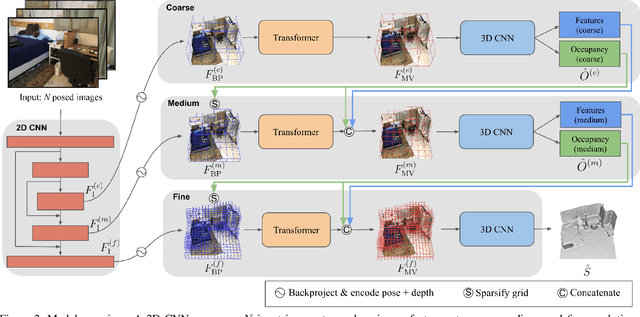

Abstract:Recent volumetric 3D reconstruction methods can produce very accurate results, with plausible geometry even for unobserved surfaces. However, they face an undesirable trade-off when it comes to multi-view fusion. They can fuse all available view information by global averaging, thus losing fine detail, or they can heuristically cluster views for local fusion, thus restricting their ability to consider all views jointly. Our key insight is that greater detail can be retained without restricting view diversity by learning a view-fusion function conditioned on camera pose and image content. We propose to learn this multi-view fusion using a transformer. To this end, we introduce VoRTX, an end-to-end volumetric 3D reconstruction network using transformers for wide-baseline, multi-view feature fusion. Our model is occlusion-aware, leveraging the transformer architecture to predict an initial, projective scene geometry estimate. This estimate is used to avoid backprojecting image features through surfaces into occluded regions. We train our model on ScanNet and show that it produces better reconstructions than state-of-the-art methods. We also demonstrate generalization without any fine-tuning, outperforming the same state-of-the-art methods on two other datasets, TUM-RGBD and ICL-NUIM.
3DVNet: Multi-View Depth Prediction and Volumetric Refinement
Dec 01, 2021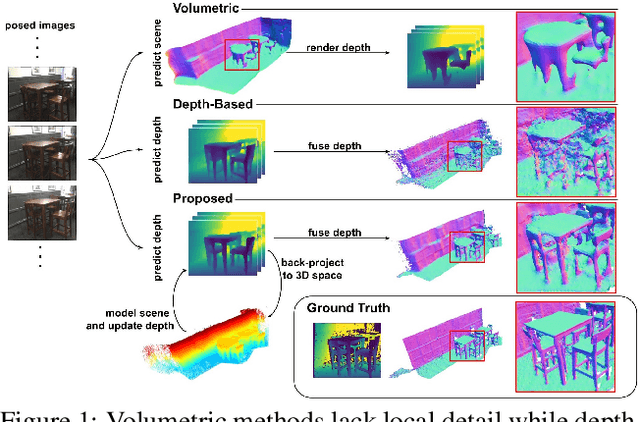

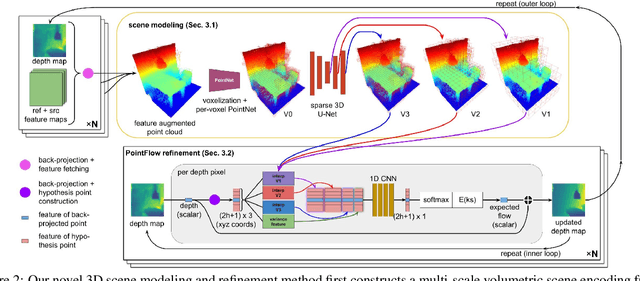

Abstract:We present 3DVNet, a novel multi-view stereo (MVS) depth-prediction method that combines the advantages of previous depth-based and volumetric MVS approaches. Our key idea is the use of a 3D scene-modeling network that iteratively updates a set of coarse depth predictions, resulting in highly accurate predictions which agree on the underlying scene geometry. Unlike existing depth-prediction techniques, our method uses a volumetric 3D convolutional neural network (CNN) that operates in world space on all depth maps jointly. The network can therefore learn meaningful scene-level priors. Furthermore, unlike existing volumetric MVS techniques, our 3D CNN operates on a feature-augmented point cloud, allowing for effective aggregation of multi-view information and flexible iterative refinement of depth maps. Experimental results show our method exceeds state-of-the-art accuracy in both depth prediction and 3D reconstruction metrics on the ScanNet dataset, as well as a selection of scenes from the TUM-RGBD and ICL-NUIM datasets. This shows that our method is both effective and generalizes to new settings.
Sparse Fusion for Multimodal Transformers
Nov 24, 2021



Abstract:Multimodal classification is a core task in human-centric machine learning. We observe that information is highly complementary across modalities, thus unimodal information can be drastically sparsified prior to multimodal fusion without loss of accuracy. To this end, we present Sparse Fusion Transformers (SFT), a novel multimodal fusion method for transformers that performs comparably to existing state-of-the-art methods while having greatly reduced memory footprint and computation cost. Key to our idea is a sparse-pooling block that reduces unimodal token sets prior to cross-modality modeling. Evaluations are conducted on multiple multimodal benchmark datasets for a wide range of classification tasks. State-of-the-art performance is obtained on multiple benchmarks under similar experiment conditions, while reporting up to six-fold reduction in computational cost and memory requirements. Extensive ablation studies showcase our benefits of combining sparsification and multimodal learning over naive approaches. This paves the way for enabling multimodal learning on low-resource devices.
 Add to Chrome
Add to Chrome Add to Firefox
Add to Firefox Add to Edge
Add to Edge